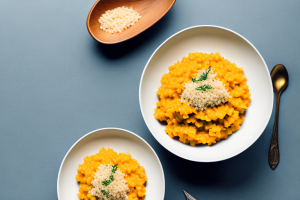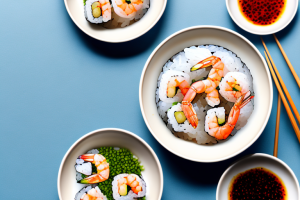How to cook arborio rice with butternut squash and sage
8 min read
A pot of cooked arborio rice with butternut squash and sage
If you’re looking for a delicious and healthy dish that’s perfect for any occasion, you should definitely try arborio rice with butternut squash and sage. This recipe is bursting with flavor and texture, making it a crowd-pleaser for both vegetarians and meat-eaters. But cooking this dish can be intimidating for beginner chefs. In this article, we will show you how to cook arborio rice with butternut squash and sage in depth, covering everything from nutritional value to cooking techniques and serving suggestions.
The nutritional value of arborio rice, butternut squash and sage
Before we dive into the cooking process, let’s take a look at the nutritional value of the main ingredients: arborio rice, butternut squash, and sage. Arborio rice is a type of rice that contains a high level of starch, making it perfect for risotto. It’s also a good source of fiber and vitamins B and E. Butternut squash is low in calories and high in fiber, making it an excellent choice for weight management. It’s also rich in vitamin A and vitamin C, promoting healthy skin and a strong immune system. Sage contains compounds that have anti-inflammatory and antibacterial properties, making it great for digestion and immune health. By combining these three ingredients in one dish, we create a nutritious and balanced meal that provides us with essential nutrients.
In addition to their nutritional benefits, arborio rice, butternut squash, and sage also offer unique flavors and textures to a dish. Arborio rice has a creamy texture when cooked, which pairs well with the sweetness of butternut squash and the earthy, slightly bitter flavor of sage. Butternut squash can be roasted or pureed to add a sweet and nutty flavor to a dish, while sage can be used fresh or dried to add a savory and slightly peppery taste. By combining these flavors and textures, we can create a delicious and satisfying meal that not only nourishes our bodies but also satisfies our taste buds.
Preparing the ingredients: tips and tricks for cutting butternut squash and sage
Now that we understand the benefits of each ingredient, let’s move on to the preparation stage. Butternut squash can be challenging to cut, so it’s crucial to follow some simple tips to make the process smoother. First, use a sturdy knife and a cutting board to prevent injuries. Second, cut off both ends of the squash and slice it in half lengthwise. Then, scoop out the seeds and discard them. Finally, cut the squash into small cubes or wedges, depending on the recipe. For the sage, rinse it under cold water and pat it dry with a paper towel. Remove the leaves from the stem and chop them finely, keeping a few whole leaves for garnish.
When it comes to cooking with butternut squash, there are a few additional tips to keep in mind. For example, roasting the squash can bring out its natural sweetness and enhance its flavor. To do this, toss the cubed squash with some olive oil, salt, and pepper, and spread it out on a baking sheet. Roast in the oven at 400°F for 20-25 minutes, or until tender and caramelized.
As for the sage, it’s a versatile herb that can be used in a variety of dishes. In addition to chopping it finely, you can also use whole leaves to infuse flavor into soups, stews, and sauces. Simply add a few leaves to the pot and let them simmer for a few minutes before removing them. This will give your dish a subtle, earthy flavor that pairs well with the sweetness of butternut squash.
How to choose the best quality arborio rice, butternut squash and sage
Choosing the right ingredients is just as important as preparing them properly. When it comes to arborio rice, look for brands that specialize in risotto rice, as their products will have a higher starch content. For butternut squash, aim for a medium-sized squash with a firm and smooth skin. Avoid squash with bruises or soft spots, as they indicate that the squash is not fresh. For sage, choose leaves that are vibrant green and free of dark spots. Since sage has a strong flavor, using fresh sage is preferable to dried sage for this dish.
Another important factor to consider when choosing arborio rice is the origin. Italian arborio rice is considered the best quality, as it is grown in the traditional way and has a unique flavor and texture. When selecting butternut squash, it is also important to check the stem. If the stem is still attached and looks fresh, it is a good sign that the squash is recently harvested and of good quality.
When it comes to sage, it is important to note that different varieties of sage have different flavors. For this dish, it is recommended to use common sage, which has a slightly bitter and earthy flavor that pairs well with the sweetness of the butternut squash. If you are unable to find fresh sage, dried sage can be used as a substitute, but be sure to use it sparingly as it has a more concentrated flavor than fresh sage.
Tips for perfectly cooked arborio rice with a fluffy texture
Now that we have the ingredients ready, we come to the most crucial step: cooking the arborio rice to perfection. Arborio rice requires constant attention and gentle stirring to ensure a creamy and tender texture. First, bring the chicken or vegetable stock to a simmer in a separate pot. In a large pan, heat some olive oil or butter on medium heat and add the arborio rice. Stir the rice for a few minutes until it turns translucent. Then, add a ladle of hot stock to the rice and stir gently until the liquid is absorbed. Repeat this process until the rice is cooked but still slightly firm. This should take around 20 minutes. The risotto should have a creamy texture but not be too runny or too thick. If the rice appears dry, add a little more stock or water.
One important tip to keep in mind while cooking arborio rice is to avoid over-stirring it. While it is important to stir the rice gently and frequently, over-stirring can cause the rice to break down and become mushy. Another tip is to add any additional ingredients, such as vegetables or cheese, towards the end of the cooking process to prevent them from becoming too soft or losing their flavor. With these tips in mind, you can create a delicious and perfectly cooked arborio rice dish every time.
How to make butternut squash soft and caramelized
Adding the butternut squash to the risotto brings a sweet and nutty flavor to the dish. To achieve a soft and caramelized texture, add the butternut squash when the rice is half-cooked. You can also roast the butternut squash separately in the oven with some olive oil and salt, then add it to the risotto at the end. This will give the squash a crispy outside and a tender inside.
Cooking sage to release its aroma and flavor
Sage is a herb that adds a distinctive aroma and flavor to the dish. To release its full potential, add it to the risotto at the end of the cooking process. You can also fry the sage leaves in olive oil or butter until they turn crispy and use them as a garnish. Another option is to infuse the stock with sage leaves before adding it to the rice, giving the dish a delicate fragrance.
Combining the ingredients: mixing arborio rice, butternut squash and sage
Once all the components are cooked, it’s time to combine them and let the flavors mingle. Add the butternut squash and the chopped sage to the risotto and stir gently. Let it simmer for a few minutes until the squash is tender but not mushy. If desired, add some butter or parmesan cheese for extra creaminess and richness.
Seasoning the dish: adding salt, pepper, butter or other herbs to taste
The risotto should be well-seasoned with salt and pepper, but you can also add other herbs or spices to customize the flavor. Some popular additions include garlic, thyme, rosemary, or nutmeg. Be careful not to over-season the dish, as the flavors of the ingredients should shine through.
Serving suggestions: pairing the dish with other sides or main courses
This arborio rice with butternut squash and sage dish can be served as a side or a main course, depending on the occasion. You can pair it with roasted chicken, baked salmon, or grilled mushrooms for a complete meal. It’s also delicious with a side of steamed broccoli or a mixed green salad. For a vegetarian option, top it with some roasted nuts or seeds for added crunch.
Alternative recipes: variations of this recipe using different grains or vegetables
If you’re feeling adventurous, you can experiment with alternative grains or vegetables for this dish. Some tasty options include quinoa, barley, or farro as a substitute for arborio rice. For the vegetables, try adding roasted Brussels sprouts, sweet potatoes, or kale for extra nutrition. You can also swap sage for other herbs like basil, parsley, or cilantro to create a unique flavor profile.
Storing leftovers: how to keep the dish fresh for a few days
This arborio rice with butternut squash and sage dish can be stored in an airtight container in the refrigerator for up to three days. Reheat it in the microwave or on the stovetop with some additional stock or water to retain its creamy texture. You can also freeze it for up to a month, but be aware that the texture may change slightly.
Nutritional benefits of this dish for vegetarians and vegans
This arborio rice with butternut squash and sage dish is a great option for vegetarians and vegans, as it provides plenty of protein, fiber, and vitamins. By using vegetable stock instead of chicken stock and skipping the butter or cheese, you can make it entirely plant-based. It’s also gluten-free and nut-free, making it suitable for those with food allergies or intolerances.
Family-friendly meal ideas: serving this dish to picky eaters
If you’re cooking for picky eaters, you can adjust this recipe to suit their taste buds. For example, if your child doesn’t like butternut squash, you can substitute it with some roasted carrots or zucchini. If someone doesn’t like the texture of arborio rice, you can use basmati or jasmine rice instead. You can also incorporate some mild spices like cumin or paprika to make it more appealing to the palate.
How to make this recipe ahead of time for a stress-free dinner party
If you’re hosting a dinner party and want to serve this dish, you can prepare some of the components ahead of time to reduce stress on the day. You can chop the butternut squash and sage leaves the day before and store them in the fridge in separate containers. You can also make the risotto base and keep it in the fridge for up to a day. On the day of the party, combine all the ingredients and heat them up in a pan or in the oven. This way, you can present a fresh and delicious dish without spending too much time in the kitchen.
Now you have all the knowledge and techniques to make a fantastic arborio rice with butternut squash and sage dish. Whether you’re a seasoned chef or a beginner cook, this recipe is easy to follow and provides many options for customization. Remember to choose high-quality ingredients, cook the rice to perfection, and season it well. This dish is perfect for any occasion, from a simple weeknight dinner to a fancy dinner party. Enjoy!


